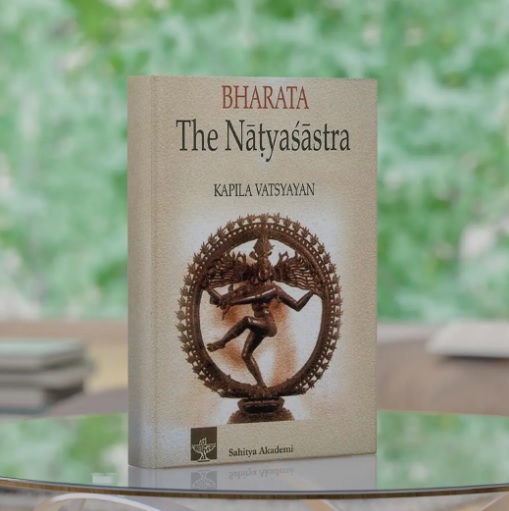- Visitor:59
- Published on: 2024-09-10 02:38 pm
The Polysemy of ‘Śāstra’ Apropos of the Nāṭyaśāstra

In order to understand the text in the Indian
tradition an analogy would be pertinent. Whether it is the Mahābhārata
or the Nāṭyaśāstra, these are texts with a seed which has a
distinctiveness, like a genetic distinctiveness. It grows like a tree and it
gives out shoots like aśvatha. In the case of the Natyasastra the
possibility of multiple readings is inbuilt in the text; it does not explicitly
state the possibilities of multiple texts or multiple writing. However, as we
shall observe in a later chapter, it is from the seeds of this very text that
other trees grow.
Before we examine more closely the structure
and contents of the Nāṭyaśāstra, it may also be useful to pause here to
consider not only the general nature of text— verbal, oral or written– but the
pointed question of what constitutes a sastra in the Indian tradition
generally, more specifically in the arts. Why is a category of writing called a
śāstra?
There have been countless equivalents of the
word śāstra in English, of ‘theory’, ‘code’, ‘manual’, ‘treatise’,
‘scientific text’. Also, śāstra is distinguished in literature and the
arts as being a category distinct from the creative. While in the English
language, we can easily use the terms ‘creative and critical literature’,
‘creative and technical literature’, when the terms are transferred to the
sphere of the Indian, for that matter, the Asian arts, there is some difficulty.
Can we juxtapose kāvya (poetry, epic or lyrical) and śāstra, and nāṭya
(drama) and śāstra as being opposites or use a generic term as kalpanā
(imagination) and racanā (composition) or and use the word sastra
as an antonym or perhaps coin a pair sāhitya (literature) and samalocana
(criticism) or kavitā (poetry) and samālocanā (criticism) as in
contemporary parlance in Hindi and other literature?
The śāstra within the tradition, cannot
be equated, so far as one can gather, from the śāstras in different
fields and disciplines, to ‘critical writing’ or criticism, as used in
contemporary scholarship. Can we then equate the category of śāstra with
theory, and then use it for the spheres of dharma, nīti, cikitsā, etc.? Can
we juxtapose the term with the antonym of ‘practice’ and suggest another pair
of binary opposites of modern discourse, i.e. of ‘theory’ and ‘praxis’? Or, can
we speak of śāstra only as prescriptive and understand the word prayoga
as experimentation and innovation as used in contemporary Indian literature,
specially, Hindi?
Let us look at both these levels. First, the
domains of human activity and knowledge covered by the texts which can be
categorized as sastra and second, the adjectival and adverbial use of
the term when used as śāstrīya nṛtya, śāstric, etc.
In regard to the first, one knows that within
the Indian tradition, the range of subjects covered by the śāstras is
extensive, as they cover all possible human activities– from cooking to horse
and elephant breeding, performing, love-making to social conduct, economic
organization, justice and much else and, of course, all the arts– from
architecture to poetry. Now, if we look at this range closely, we will find
that all these activities and disciplines are subsumed in the three more basic
categories of human endeavor defined in the Indian world-view. Amongst the
four-fold spheres and goals (i.e. puruṣārthas), the śāstras
relate to the sphere of dharma, artha and kāma, but not mokṣa
the final. There is, for example, no ātman or mokṣa śāstra
although the goal of each of these may be mokṣa (liberation). The
exclusion of the last is a pointer to a recognition of a dimension of life
endeavor where classifications, ‘grammar’ rules, or even intellection is of
little significance. One could deduce from this that śāstras are in the
sphere of measure, of ‘organization’, of ‘metho-dologies’ alluding to the
infinite perhaps, but are in the finite’. In common parlance, the Puranas and
other texts are alluded to as mokṣa śāstra, but these should only be
considered as the texts that lead to mokṣa, but are not texts of mokṣa.
Now, if we look at some of these texts, especially
in the arts, we find that they are largely couched in a cryptic language which
often sounds like algebraic formulae and is, at least on the surface,
prescriptive. Little wonder that they have called ‘recipe’ books for cooking
meals. In common parlance, they have been described through several English
equivalents such as ‘treatise’, ‘manual’, ‘codes’, etc.
In regard to the second level, i.e.
juxtaposing the terms ‘theory’ and ‘praxis’ with śāstra and prayoga,
or using the adjectival forms of śāstrīya sangīta, nṛtya, etc., we find
that the Nāṭyaśāstra at least does not consider śāstra and prayoga
(i.e. theory and praxis) as antonyms or in opposition. Instead, Bharata asserts
at the very outset that he is writing a prayoga śāstra. Translated
literally in modern usage, it would amount to saying that he is writing a
‘theory’ of ‘praxis’. We may even suggest that he is alluding to a prescriptive
text of ‘praxis’ and ‘practice’. Paradoxical as it may sound, this is indeed
what he sets out to do, and what distinguishes his work as also of others, both
from being cook-books or manuals on the one hand, and abstract theoretical
discourses, on the other. The dictionary meaning of the word śāstra (Monier-Williams)
as an order, a command, rule, teaching, direction, instruction manual,
conforming to sacred precepts, would obviously need considerable modification
and explanation if we are to evaluate these categories from within the
tradition on its own terms, before equating them with others which carry with
them a valid and legitimate ‘load’ of another stream of thought and discourse.
The English word ‘theory’, with its long, distinguished and perfectly
understandable history, implies knowledge or pure science as such without
reference to applicability. Further, it is accepted that a theory is a
tentative statement of a supposed principle or relationship of cause and
effect, in short, a working hypothesis. In its derivative and extended meaning,
it suggests abstract principles and universals of any body of related facts.
The category of ‘śāstra’ does not
denote the purely speculative and contemplative – it may or does suggest
abstraction of principles from a body of facts, or more precisely, the phenomenon
of practice. It is in this sense and with these improvisos that we have used
the word ‘theory’ for sastra in this discussion.
The Nāṭyaśāstra as a text has to be
viewed, thus, neither as ‘theory’ as understood in its Greek connotation, nor
as a ‘manual’ or a series of ‘commands’ or precepts of sacred knowledge. It is
a ‘category’ apart, which moves on many levels, some implicit, others explicit
and explanatory. It is, it was, an abstraction, a deduction from experience and
practice, and in turn can play an inductive role. The sifting of a large body
of data in a particular field of activity of human life and its systemized
arrangement as broad principles are its distinguishing features. The
fundamentals so proposed are subject to both multiple interpretations and
modifications in a specific time, place and situation.
As regards the recent use of the term śāstra
an adjective, śāstrīya nṛtya or sangīta, it suggests quality of
performance, sometimes genre, with an implied translation of the term ‘classical’
in English, as a qualitative and not historical period category.
Elsewhere, we have elaborated on the jigsaw
puzzle of categories and terms in Sanskrit and their English equivalents. Here,
it is necessary to draw attention to the particular category of knowledge and
discourse to which our text belongs within a larger body of knowledge and its
epistemology.
As has been pointed out, Bharata is at pains
to remind his readers and listeners repeatedly that the efficacy of the
formulation lies in practice (prayoga); also, that the text can be
interpreted and changed according to the needs of ‘time’ and ‘place’. He allows
for both continuity and flow, as also change.
We have also to take into account of the
‘dynamics’ of the oral and the ‘written’, more, the silent shared experience
and transmission in words. The algebraic formulae or aphoristic character was
natural and understandable because like modern software with codes, the
articulated word was only an indicator, stimulator of a larger shared and
transmitted knowledge. Initiated training and practical experience was
essential.
The nāṭya or vāstu or śilpa śāstras
existed within a cultural milieu of (a large body of) shared and transmitted
knowledge, practical expertise, and systemized methodologies of oral
transmission. The written texts, as they have come down to us through
manuscripts and published editions, represent a ‘residual’ record of this
larger and also more exact communication. They are not the totality, they only
reflect a ‘totality’ and have to be viewed as such.
The history of the search and discovery of the
manuscripts, the fragmentary nature of the evidence, the endeavor of arriving
at one authentic text, has now to be juxtaposed with the need to recognize the
large cultural matrix, the categories of knowledge and discourses evolved and
the methods of transmission.
The text is the one and only evidence we have–
indispensable and invaluable– and yet each text is perhaps a fragment or a
small prototype of a great monument, not of ‘brick’ and ‘stone’, but of
experience, speculation, thought and practice, shared and lived.
One last point in the context of the textual
tradition of the Indian arts is pertinent. Can any text in the Indian arts be
considered exclusive in terms of the modern categories of architecture,
sculpture, painting, music, dance, drama and poetry? Are the categories of vāstu,
śilpa, citra, sangīta, nāṭya, sāhitya, kāvya insulated, autonomous,
inclusive or exclusive? If not, then, what is the internal interdisciplinary or
interpretation system? How do these texts, and the Nāṭyaśāstra as the
earliest of them all, approach the question of the autonomy and specificity of
each art-form and its intrinsically inter-related character?
An examination of these texts, except in the
case of poetics and rhetorics, reveals that in each case the particular śāstra
(nāṭya or vāstu or sangīta) identifies a principal genre
or form and then invariably considers the role of the other arts in the
structure of the principal. Thus, drama (nāṭya) not only considers but
comprises architecture, dance, music, poetry and painting. Vāstu
(architecture) comprises sculpture, painting and dance, and sangīta
(music) considers the physiological systems, poetry and dance and so on. There
is an integral vision which blooms in a multiplicity. It is not an aggregation
of disciplines. It is an interpretation of disciplines. For facility, we may
call it an integral multidisciplinary approach.
We shall endeavor to look at the Nāṭyaśāstra
at its implicit and explicit levels, its structure and design, the
inter-relatedness of the arts and its language of form and technique,
throughout reminding ourselves that our text is neither pure theory nor a
working hypothesis or manual or rule-book or a handy guide for practitioners of
the arts.
Instead, it reflects a world-view, is embedded
in a cultural context, shares a vast body of knowledge in many disciplines, was
perhaps orally transmitted for centuries through a highly systemized
methodology of transmission, teacher to pupil, pedagogic schools, is inter- and
multi-disciplinary in nature, and is Pan-Indian.
The Nāṭyaśāstra is an ocean, certainly a confluence. An attempt at analysis can only be inadequate despite the fact that from the sixth century to the eighteenth century it was followed and commented upon, and now for a hundred years or more, modern scholarship has attempted a critical assessment of the seminal text.
- 29 min read
- 0
- 0










